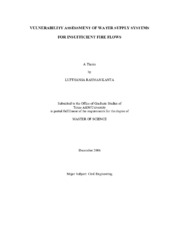| dc.description.abstract | Water supply systems’ vulnerability towards physical, chemical, biological, and
cyber threats was recognized and was under study long before September 11, 2001. But
greater attention toward security measures for water supply systems was focused after
the incidents of September 11, 2001. In response to those events, several acts have been
passed by the United States Congress, and numerous vulnerability assessment tools and
methodologies for water systems have been developed. Although water supply systems
are vulnerable to many forms of terrorist acts, most of the vulnerability analysis studies
on these systems have been for chemical and biological threats. Because of the
interdependency of water supply infrastructure and emergency fire response, any
substantial damage in a water system would be a significant threat towards the
community.
In this study, attention is focused toward physical threats on water supply
systems during a fire flow condition, and a methodology is developed to determine the
vulnerable components of a water supply system during a fire event. The methodology
utilizes dynamic programming optimization procedure to determine maximized disruption of fire flows as a function of number of attacks and/or failures in the water
distribution system. Disruption is quantified at specific fire hydrants in two schemes
using normalized values of (1) available flow and (2) available pressure and distance to
the nearest operational fire hydrant. It is found that the pressure-based quantity is
inferior to the flow-based one. However, using the flow-based disruption metric, clear
functions of disruption versus failure number can be determined that exhibit discernable
properties of robustness and resiliency – and the sequential failures in each.
This methodology is applied to the water supply system of Micropolis, a virtual
city developed by Brumbelow et al. (2005), and vulnerability analysis is performed with
fire at several possible locations. On the basis of the results, three mitigation strategies
are proposed to harden specific sets of water mains and more simulations are performed
on the hardened water supply system to assess its changed vulnerability. The results
from the simulations of the mitigation strategies show that the recommendations on
specific mitigation measures reduce the serious consequences from such threats. | en |


